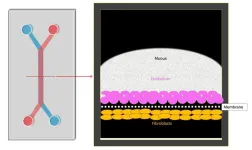(Press-News.org) MIAMI, FLORIDA (May 30, 2024) – Many countries with national healthcare systems or payers such as insurance companies use cost-effectiveness analyses to decide whether to cover new medicines, balancing treatment costs with potential health benefits.
That strategy often limits access to new, targeted therapies, even when these drugs prove highly effective and become part of standard-of-care therapy for many patients.
A new study from Sylvester Comprehensive Cancer Center at the University of Miami Miller School of Medicine examined the cost-effectiveness of durvalumab, a targeted immunotherapy for lung cancer that is known to extend lifespan. The findings show that the drug exceeded official cost-effectiveness thresholds for all four analyzed countries: the United States, Brazil, Singapore and Spain.
The study could help guide drug-pricing strategies to reduce financial burdens and increase the number of patients who benefit from treatment.
“Cost-effectiveness analyses can help establish a value-based price for discussions with payers,” including insurance companies and national health care systems, said senior author Gilberto Lopes, M.D., chief of Medical Oncology and medical director for International Affairs at Sylvester.
Cost-effectiveness analyses can also inform biopharma companies about barriers to access, resulting in pricing-structure changes for targeted drugs in different countries, he added.
That’s a key aim of the Access to Oncology Medicines (ATOM) Coalition, a global initiative chaired by Lopes to improve access to oncology treatments in low-income countries.
Effective but Unavailable
Since its approval for lung cancer in 2018, durvalumab has become part of the standard of care for the disease. The drug is used as a maintenance therapy, usually for a year, after primary chemotherapy for unresectable (inoperable), locally advanced non-small cell lung cancer (NSCLC).
The drug extends lifespan by more than 18 months compared to placebo, according to an analysis of five years of data from the PACIFIC clinical trial.
Despite its effectiveness, durvalumab access is limited in some settings. In Brazil, for instance, the drug was approved in 2020 but remains unreimbursed by its public health system.
Calculating Cost-effectiveness
In this new study, published in the Journal of the American Medical Association Open Access, the researchers developed a model to assess durvalumab’s treatment costs and health benefits in lung cancer patients over a 10-year period.
To calculate treatment costs, the researchers collected a wide range of data, including drug pricing in different countries, administration costs, adverse events and follow-up care. In the U.S., the cost of treatment with durvalumab was $114,394.
To quantify health benefits, the researchers used a measurement commonly used in economic evaluations called quality-adjusted life years (QALYs). This data combines lifespan gains with information on quality of life.
The researchers then generated a single metric called an incremental cost-effectiveness ratio. The researchers found that the cost-effectiveness ratio in the U.S. for durvalumab was $228,788 per QALY.
Though Medicaid and Medicare typically pay for the drug, this cost-effectiveness ratio exceeds the agencies’ threshold target of $150,000. The cost-effectiveness ratios also exceed health system thresholds in the other analyzed countries.
Overall, the study authors concluded that durvalumab treatment for lung cancer remains globally “cost-prohibitive.”
The researchers went on to show how reduced industry pricing can improve cost-effectiveness. This analysis used discounted prices in Singapore that are available through an industry pricing program. The program brought the cost-effectiveness ratio down from $153,461 per QALY to $45,164 — below the official threshold in Singapore.
Increasing Access
“The overall goal of these types of studies is to shed a very academic, and hopefully neutral light on all these numbers,” said study first author Samuel Kareff, M.D., Sylvester’s chief hematology and oncology clinical fellow. Dr. Kareff will also present the data May 30 as an invited speaker at the OncLive National Fellows Program.
The study’s strengths include accounting for multiple lines of therapy and using biomarker-guided treatments in its model (durvalumab targets a molecule called PD-L1, which is typically screened for prior to treatment). Limitations of the study include its narrow global coverage and the lack of analyses in poorer countries where access is more restrictive, Kareff explained.
He noted that drug companies face the challenge of recouping their massive drug-development costs while ensuring patients are served. Cost-effectiveness analyses can help, he said.
In May, Bristol Myers Squibb released its 10-year strategy to improve access to treatments for patients in low- and middle-income countries, including a collaboration with the ATOM Coalition to increase access to another targeted immunotherapy, nivolumab.
“As the pace of innovation increases and more targeted therapies become available, we unfortunately expect treatment costs to increase as well,” Kareff said.
about Sylvester research on the InventUM Blog, and follow @SylvesterCancer on X for the latest news on its research and care.
# # #
Authors: A complete listing of authors is available in the paper.
Article Title: International Cost-Effectiveness Analysis of Durvalumab in Stage III Non-Small Cell Lung Cancer
DOI: 10.1001/jamanetworkopen.2024.13938
Funding and Disclosures: Funding and disclosures are available in the paper.
END
Alex Aliper, PhD, president of global clinical stage artificial intelligence (AI)-powered drug discovery company Insilico Medicine (“Insilico”) will present at the Systems Aging Gordon Research Conference, a leading international scientific conference focused on advancing the frontiers of science through the presentation of cutting-edge and unpublished research. On Wed., June 5, 10:40 am, Dr. Aliper will give a talk titled "Generative Artificial Intelligence and Next-Generation Robotics for Drug Discovery and Longevity Research."
The conference ...
The Ecological Society of America is pleased to announce the winners of its 2024 awards, which recognize outstanding contributions to ecology in new discoveries, teaching, sustainability, diversity and lifelong commitment to the profession.
These awards are designed to not only reward past achievements, but also to inspire a broad audience of scientists, educators and students, opening the door to new insights and collaborations that will further the impact of ecological research.
“The Ecological Society of America is immensely proud to honor this year’s distinguished awardees,” said ESA President ...
A team including researchers from the Texas A&M University School of Public Health and School of Medicine has found that high resolution mass spectrometry could be a valuable tool for identifying and assessing air-borne contaminants produced by natural and man-made disasters. Their findings were published in the Journal of Exposure Science & Environmental Epidemiology.
The scientists used high resolution mass spectrometry—a highly accurate means of identifying molecular compounds in a sample—in fall 2023 to identify volatile organic ...
Human cervix modeled in microfluidic organ chip fills key women's health gap
Engineered cervix with in vivo-like mucus production, hormone sensitivity, and associated microbiome creates novel testbed for bacterial vaginosis therapeutics and other treatments
By Benjamin Boettner
(BOSTON) — Bacterial Vaginosis (BV) has been identified as one of the many unmet needs in women's health and affects more than 25% of reproductive-aged women. It is caused by pathogenic bacteria that push the healthy microbiomes in the female vagina and cervix – the small gatekeeper canal that connects the uteruns and vagina – into a state of imbalance known as dysbiosis. ...
Humans may be accelerating the rate at which organic matter decomposes in rivers and streams on a global scale, according to a new study from the University of Georgia, Oakland University and Kent State University.
That could pose a threat to biodiversity in waterways around the world and increase the amount of carbon in Earth’s atmosphere, potentially exacerbating climate change.
Published in Science, the study is the first to combine a global experiment and predictive modeling to illustrate how human impacts to waterways may contribute to the global climate crisis.
“Everyone in the world needs water,” ...
Factual yet misleading vaccine content was 46 times more effective at driving vaccine hesitancy than flagged misinformation, reports a new study exploring real-world impacts of misinformation exposure. A second study aiming to better understand the characteristics of “supersharers” – a small group of individuals increasingly found to spread misinformation – reports that just over 2,000 supersharers on X (formally Twitter) spread 80% of the fake news during the 2020 US presidential election; the study involved a sample of more than 660,000 voters on X and uncovered that the supersharers were mainly middle-aged Republican women in conservative states.
Misinformation, ...
Cuckoos – which lay their eggs in nests of other birds – have higher speciation rates when they lay their eggs in a broader range of host bird species’ nests, a new study reports. This higher speciation rate is driven by host rejection and cuckoo selection for mimetic nestling traits. How new species arise is a fundamental question in biology. Coevolution between closely interacting species is thought to increase biodiversity and potentially explain the vast number of distinctly specialized species. However, evidence linking macroevolutionary patterns to microevolutionary ...
Coupling skin bacteria-laden hydrogel and electronics, researchers have introduced the ABLE platform, a bioelectronics system that can deliver management and adaptive treatment of skin inflammation. They test this approach in a mouse model of psoriasis. The findings demonstrate the potential for clinical application of bioelectronics devices that promote drug-free therapeutic effects through a living hydrogel interface. “This amalgamation of living and synthetic components is a notable advance toward ...
Integrating big data and a coordinated global field experiment, researchers have developed a model that can predict the decomposition rate of organic matter in rivers worldwide. The global model estimates decomposition rates in rivers across vast understudied areas of Earth, revealing rapid decomposition across continental-scale areas dominated by human activities. Earth's terrestrial ecosystems generate over 100 billion tons of plant detritus annually, with its fate – long-term storage, mineralization to greenhouse gasses, or incorporation into food webs – determined by decomposition rates. This organic material is continually added to rivers ...
Negating an adjective by placing ‘not’ in front of it affects the way our brains interpret its meaning, mitigating but not entirely inverting our interpretation of its definition. In a study published May 23rd in the open-access journal PLOS Biology, Arianna Zuanazzi at New York University, US, and colleagues offer insight into how the brain represents changes of meaning over time and offer new methods for further linguistic research.
The way the brain processes negated adjectives — ‘not bad’ or ‘not ...






